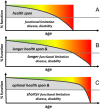Functional aging in health and heart failure: the COmPLETE Study
- PMID: 31362698
- PMCID: PMC6664502
- DOI: 10.1186/s12872-019-1164-6
Functional aging in health and heart failure: the COmPLETE Study
Abstract
Background: Cardiovascular (CV) diseases including heart failure are the leading causes of morbidity, with age being the primary risk factor. The combination of age-related organic functional impairment and reduced physical fitness can drastically impact an individual's healthspan. One's lifespan can potentially be prolonged by the preservation or improvement of physical fitness. However, it remains unclear as to which biomarkers are most suitable for distinguishing between healthy aging and the impaired organ function associated with heart failure. Therefore, a comprehensive assessment of the components of physical fitness and CV function will be performed to identify the most important factors contributing to aging in relation to both health and disease.
Methods: This cross-sectional investigation will consist of two parts: COmPLETE-Health (C-Health) and COmPLETE-Heart (C-Heart). C-Health will examine the aging trajectories of physical fitness components and CV properties in a healthy population sample aged between 20 and 100 years (n = 490). Separately, C-Heart will assess the same markers in patients at different stages of chronic heart failure (n = 80). The primary outcome to determine the difference between C-Health and C-Heart will be cardiorespiratory fitness as measured by cardiopulmonary exercise testing on a bicycle ergometer. Secondary outcomes will include walking speed, balance, isometric strength, peak power, and handgrip strength. Physical activity as a behavioural component will be assessed objectively via accelerometry. Further, CV assessments will include pulse wave velocity; retinal, arterial, and venous diameters; brachial and retinal arterial endothelial function; carotid intima-media thickness; and systolic and diastolic function. The health distances for C-Health and C-Heart will be calculated using the methodology based on statistical (Mahalanobis) distance applied to measurements of quantitative biomarkers.
Discussion: This research seeks to identify physical fitness and CV biomarkers that best resemble underlying CV risk with age. Further, it will examine which physical fitness markers are impaired most in heart failure. The presented integrative approach could define new recommendations for diagnostic guidance in aging. Ultimately, this study is expected to offer a better understanding of which functional characteristics should be specifically targeted in primary and secondary prevention to achieve an optimal healthspan.
Keywords: Aging; Exercise; Fitness; Heart failure; Vascular function.
Conflict of interest statement
The authors declare that they have no competing interests.
Figures


Similar articles
-
Exercise, Arterial Crosstalk-Modulation, and Inflammation in an Aging Population: The ExAMIN AGE Study.Front Physiol. 2018 Feb 21;9:116. doi: 10.3389/fphys.2018.00116. eCollection 2018. Front Physiol. 2018. PMID: 29515458 Free PMC article.
-
Cardiopulmonary exercise capacity and quality of life of patients with heart failure undergoing a functional training program: study protocol for a randomized clinical trial.BMC Cardiovasc Disord. 2020 Apr 25;20(1):200. doi: 10.1186/s12872-020-01481-6. BMC Cardiovasc Disord. 2020. PMID: 32334527 Free PMC article.
-
Arterial stiffness is associated to cardiorespiratory fitness and body mass index in young Swedish adults: The Lifestyle, Biomarkers, and Atherosclerosis study.Eur J Prev Cardiol. 2017 Nov;24(17):1809-1818. doi: 10.1177/2047487317720796. Epub 2017 Jul 11. Eur J Prev Cardiol. 2017. PMID: 28696134
-
Low Fitness in Midlife: A Novel Therapeutic Target for Heart Failure with Preserved Ejection Fraction Prevention.Prog Cardiovasc Dis. 2015 Jul-Aug;58(1):87-93. doi: 10.1016/j.pcad.2015.05.007. Epub 2015 May 13. Prog Cardiovasc Dis. 2015. PMID: 25982216 Review.
-
The importance of physical activity and cardiorespiratory fitness for patients with heart failure.Diabetes Res Clin Pract. 2021 Jun;176:108833. doi: 10.1016/j.diabres.2021.108833. Epub 2021 Apr 23. Diabetes Res Clin Pract. 2021. PMID: 33895194 Review.
Cited by
-
Methodological aspects for accelerometer-based assessment of physical activity in heart failure and health.BMC Med Res Methodol. 2021 Nov 14;21(1):251. doi: 10.1186/s12874-021-01350-6. BMC Med Res Methodol. 2021. PMID: 34775952 Free PMC article.
-
Advances in accelerometry for cardiovascular patients: a systematic review with practical recommendations.ESC Heart Fail. 2020 Oct;7(5):2021-2031. doi: 10.1002/ehf2.12781. Epub 2020 Jul 3. ESC Heart Fail. 2020. PMID: 32618431 Free PMC article.
-
Personalised, GIS-based counselling to promote habitual walking in mobility-limited and chronically ill older adults: protocol of the MOBITEC-Routes randomised controlled trial.BMC Geriatr. 2025 Jul 2;25(1):471. doi: 10.1186/s12877-025-06113-2. BMC Geriatr. 2025. PMID: 40604576 Free PMC article. Clinical Trial.
-
VascuFit: vascular effects of non-linear periodized exercise training in sedentary adults with elevated cardiovascular risk - protocol for a randomized controlled trial.BMC Cardiovasc Disord. 2022 Oct 27;22(1):449. doi: 10.1186/s12872-022-02905-1. BMC Cardiovasc Disord. 2022. PMID: 36303113 Free PMC article.
-
Metabolic Impairment in Coronary Artery Disease: Elevated Serum Acylcarnitines Under the Spotlights.Front Cardiovasc Med. 2021 Dec 16;8:792350. doi: 10.3389/fcvm.2021.792350. eCollection 2021. Front Cardiovasc Med. 2021. PMID: 34977199 Free PMC article.
References
-
- Global, regional, and national incidence, prevalence, and years lived with disability for 328 diseases and injuries for 195 countries, 1990–2016 A systematic analysis for the global burden of disease Study 2016. Lancet. 2017;390(10100):1211–1259. doi: 10.1016/S0140-6736(17)32154-2. - DOI - PMC - PubMed
-
- Benjamin EJ, Blaha MJ, Chiuve SE, Cushman M, Das SR, Deo R, de Ferranti SD, Floyd J, Fornage M, Gillespie C, et al. Heart disease and stroke Statistics-2017 update: a report from the American Heart Association. Circulation. 2017;135(10):e146–e603. doi: 10.1161/CIR.0000000000000485. - DOI - PMC - PubMed
Publication types
MeSH terms
Grants and funding
LinkOut - more resources
Full Text Sources
Other Literature Sources
Medical

